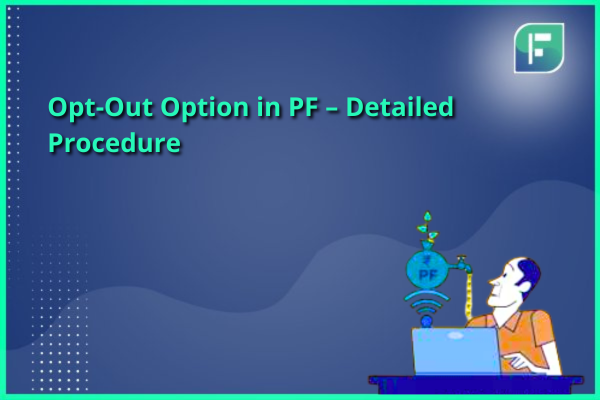The Employee Provident Fund or EPF registration serves as a retirement benefits scheme for salaried individuals in India. It requires a structured savings plan where a percentage of an employee’s salary is directed into the EPF account, contributed by both the employee and the employer. Nonetheless, some employees might decide not to take part in this scheme due to their specific financial goals or investment preferences. The positive aspect is that the EPF scheme offers an opt-out option in PF to employees, if they wish to. In this blog, we shall see the detailed procedure for utilising the Opt-Out Option in PF.
Understanding the Opt-Out Option in PF
The Employee Provident Fund scheme allows employees the opt-out option in PF and stops contributing to the scheme. However, there are specific eligibility criteria to be aware of.
This opt-out choice is accessible to employees with a monthly income below Rs. 15,000. If an employee’s earnings surpass this limit, their participation in the EPF scheme becomes mandatory, and they must follow the stipulated contribution regulations.
Steps to Use Opt-Out Option in PF
The instructions to follow for using opt-out option in PF scheme is given below:
Step 1: Visit the EPF Member Portal
Begin by accessing the EPF member portal through the following URL: https://unifiedportal-mem.epfindia.gov.in/memberinterface/.
Create an account by providing your Universal Account Number and other necessary personal information.
Step 2: Log in to the Portal
After successfully creating an account, log in using your UAN and password.
Step 3: Go to the ‘Online Services’ Section
Upon logging in, proceed to the ‘Online Services’ section and select the ‘Claim (Form-31, 19 & 10C)’ option.
Step 4: Choose the Reason for Withdrawal
Next, you must specify the reason for your withdrawal. Options include ‘Illness’, ‘Marriage’, ‘Higher Education’, ‘Purchase of land or house’, ‘Repair or modification of the house’, or ‘Any other reason’.
Step 5: Enter the Withdrawal Amount
Enter the amount you are wishing to withdraw. The permissible withdrawal amount depends on the reason you’ve selected. For instance, if you’ve chosen ‘Illness’ as the reason, you can withdraw up to six months’ basic wages and DA or the total employee share with interest, whichever is lower.
Step 6: Upload Required Documents
Upload the necessary supporting documents, such as medical certificates, wedding invitations, or land purchase documents, depending on the chosen withdrawal reason.
Step 7: Submit the Claim
After completing the previous steps, submit your withdrawal claim. The claim will undergo verification by the Employees’ Provident Fund Organisation and the approved amount will be credited to your designated bank account.
Important Points to Note Regarding EPF Opt-Out Option
1. Opt-Out Threshold based on Income: The ability to use the opt-out option in PF scheme is limited to employees earning below Rs.15,000 per month.
2. Impact on Employer’s Contribution: When an employee chooses the opt-out option in PF, they no longer qualify for their employer’s contributions to their EPF account. Consequently, only the employee’s share will be deposited.
3. Meeting Eligibility Criteria: Employees can opt out after completing two months of uninterrupted service with their employer, meeting the eligibility requirement.
4. Prior Withdrawals and Opt-Out Eligibility: If an individual has previously withdrawn from the EPF scheme at any juncture, they will not meet the criteria to exercise the opt-out option in EPF scheme.
5. Tax Implications for Early Withdrawal: Any amount withdrawn from the EPF account before completing five years of continuous service is subject to taxation, making it essential to consider tax consequences when opting for withdrawal.
How to Opt-Out of EPF
If you are eligible and wish to opt-out of the Employee Provident Fund scheme, follow these steps to initiate the process:
Step 1: Write a Request Letter
Begin by drafting a formal request letter addressed to your employer. Clearly state your intention to opt-out of EPF and provide a brief reason for your decision. Address the letter to the HR department or the individual responsible for EPF matters within your organisation.
Step 2: Submit the Request Letter
Hand over the request letter to the HR department or the designated EPF authority within your organisation. In addition to the letter, be prepared to submit supporting documents, such as proof of identity, address, and bank account details, if requested.
Step 3: Await Confirmation
Following the submission of your request letter and any required documentation, await confirmation from the EPF office. The confirmation will be communicated to your employer, who will subsequently notify you of the decision.
Step 4: Update KYC Details
Once you receive confirmation, it’s essential to update your Know Your Customer details on the Employees’ Provident Fund Organisation portal. Ensure that your bank account number, IFSC code, Aadhaar number, PAN number, and mobile number are all correctly recorded.
Step 5: Consider Opening a New NPS Account
Opting out of EPF entails giving up on retirement benefits offered by your organisation. To safeguard your financial future post-retirement, it’s advisable to explore opening a new National Pension Scheme account. This alternative avenue can effectively serve as a platform for your retirement savings.
It’s advisable to consult with a financial advisor like StartupFino to fully understand the consequences and explore suitable retirement savings alternatives.
Final Thoughts
Exercising the opt-out option in PF scheme is a decision that carries both eligibility requirements and financial considerations. Employees earning less than Rs.15,000 per month have the option to withdraw from the EPF scheme. However, this choice entails the forfeiture of the employer’s contribution to the EPF account. The process involves writing a request letter to the employer, submitting necessary documents, awaiting confirmation from the EPF office, updating KYC details, and considering alternative retirement savings, such as the National Pension Scheme.Considering the long-term financial impact of opting out is crucial, especially because early withdrawals from the EPF account can result in tax implications. Employees should proactively seek guidance from professionals like StartupFino. This will enable them to make informed decisions that align with their specific financial objectives and ensure a secure retirement.






